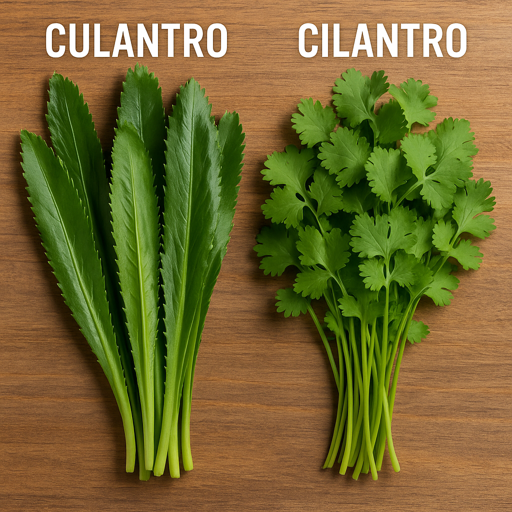When it comes to herbs, culantro and cilantro often cause confusion—not just because of their similar names, but also due to their similar aroma and taste. However, these two leafy greens are distinct in many ways: from appearance and flavor to how they’re used in cooking. In this blog, we’ll dive into the differences and similarities between culantro and cilantro, helping you become an herb expert in your kitchen or garden.
🌿 What is Cilantro?
Cilantro, also known as Coriandrum sativum, is a soft, leafy green herb widely used around the world, particularly in Indian, Mexican, Chinese, and Southeast Asian cuisines.
✅ Key Features:
- Appearance: Bright green, feathery leaves (similar to flat-leaf parsley).
- Taste: Citrusy, slightly peppery, and fresh. Some people describe it as soapy due to genetic variation.
- Plant Type: Annual herb; produces seeds called coriander.
- Used Parts: Leaves (cilantro), stems, and seeds (coriander seeds).
🍲 Common Uses:
- Garnishing curries, tacos, and chutneys.
- Added raw to salads, salsa, and guacamole.
- Integral part of chutneys and marinades in Indian cuisine.
🌱 What is Culantro?
Culantro (botanical name: Eryngium foetidum) is a tropical herb native to Central and South America and the Caribbean, and is popular in Trinidadian, Puerto Rican, Thai, and Vietnamese cooking.
✅ Key Features:
- Appearance: Long, serrated, dark green leaves with a spiky edge.
- Taste: Stronger and more pungent than cilantro, with a deeper earthy flavor.
- Plant Type: Perennial in tropical climates.
- Used Parts: Primarily the leaves.
🍲 Common Uses:
- Flavoring soups, stews, and meat dishes.
- Used in sofrito (a seasoning base in Latin cooking).
- Popular in Vietnamese pho and Caribbean pepper sauces.
🔍 Culantro vs. Cilantro: Side-by-Side Comparison
| Feature | Cilantro | Culantro |
|---|---|---|
| Botanical Name | Coriandrum sativum | Eryngium foetidum |
| Leaf Appearance | Delicate, feathery leaves | Long, spiny, serrated leaves |
| Flavor | Fresh, mild, citrusy | Bold, pungent, earthy |
| Culinary Usage | Raw garnish, salads, salsas | Cooked into dishes, stews, sauces |
| Heat Tolerance | Low (wilts easily) | High (retains flavor when cooked) |
| Growing Zone | Cooler climates (annual) | Tropical climates (perennial) |
🌍 Regional Preferences
- Cilantro is commonly used in Indian, Mexican, and European cuisines.
- Culantro is a staple in Caribbean, Southeast Asian, and Latin American dishes.
Despite their similar flavor profiles, they are rarely interchangeable in traditional recipes due to their intensity and texture. However, in a pinch, culantro can be used when cilantro is unavailable, especially in cooked dishes.
🏡 Growing Tips
✔ Cilantro:
- Grows well in cool weather.
- Needs well-drained soil and regular watering.
- Bolts quickly in heat (produces flowers and seeds).
✔ Culantro:
- Thrives in tropical or warm climates.
- Grows best in partial shade with moist soil.
- Slower to bolt, making it easier to maintain in hot weather.
🧠 Interesting Facts
- Cilantro leaves and coriander seeds come from the same plant.
- Culantro is also known as recao (in Puerto Rico), ngo gai (in Vietnam), and sawtooth herb.
- Both herbs are rich in vitamins A, C, and K, and are valued in traditional medicine for their anti-inflammatory and digestive properties.
📝 Final Thoughts
While culantro and cilantro may seem interchangeable, understanding their differences helps you choose the right herb for your recipe to elevate your dish to the next level.
If you’re adventurous in the kitchen or growing herbs at home, try both—you’ll discover how each herb brings a unique depth of flavor to your culinary creations.
📚 Sources & References:
- University of Florida IFAS Extension: Culantro: A Much Better Option for Florida Gardens Than Cilantro
- Healthline: Cilantro vs. Coriander: What’s the Difference?
- Gardening Know How: What Is Culantro – Learn How To Grow Culantro Herb

